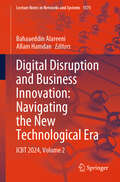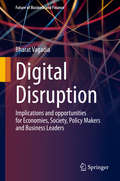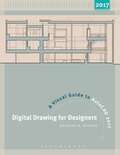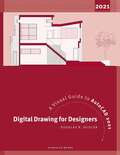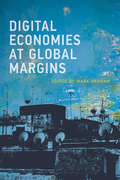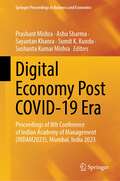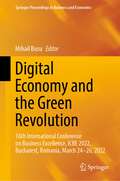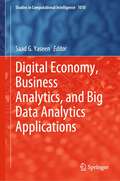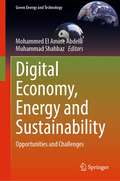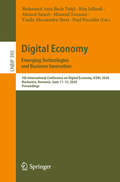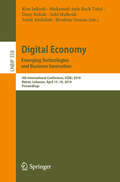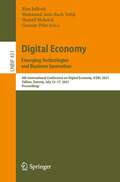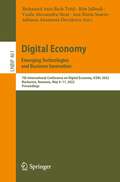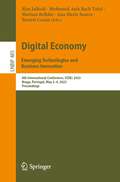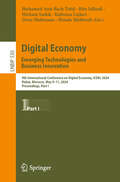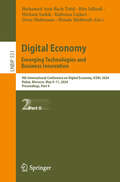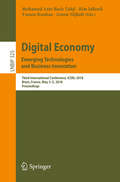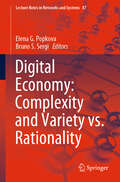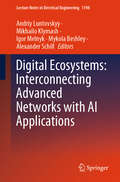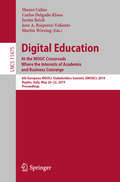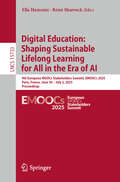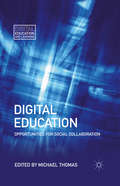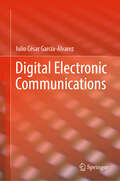- Table View
- List View
Digital Disruption and Business Innovation: ICBT 2024, Volume 2 (Lecture Notes in Networks and Systems #1573)
by Allam Hamdan Bahaaeddin AlareeniThis book examines how organizations across industries are responding to the accelerating pace of technological change, leveraging disruption as a catalyst for growth and competitive advantage. The digital revolution is not merely transforming business operations, it is fundamentally redefining the nature of innovation. Featuring a diverse collection of research, case studies, and expert insights, this book delves into the intersection of digital technologies and business innovation. From artificial intelligence and data analytics to automation and smart platforms, it highlights how emerging tools are driving bold strategies, enhancing customer experiences, and reshaping entire markets. What You&’ll Discover: · Key drivers of digital disruption in today&’s business environment · Innovative responses to change across diverse sectors · Practical frameworks for leading digital transformation ·  
Digital Disruption: Implications and opportunities for Economies, Society, Policy Makers and Business Leaders (Future of Business and Finance)
by Bharat VagadiaThis book goes beyond the hype, delving into real world technologies and applications that are driving our future and examines the possible impact these changes will have on industries, economies and society at large. It details the actions governments and regulators must take in order to ensure these changes bring about positive benefits to the public without stifling innovation that may well be the future source of value creation. It examines how organisations in a world of digital ecosystems, where industry boundaries are blurring, must undertake radical digital transformation to survive and thrive in this new digital world. The reader is taken through a framework that critically examines (i) Digital Connectivity including 5G and IoT; (ii) Data Capture and Distribution which includes smart connected verticals; (iii) Data Integrity, Control and Tokenisation that includes cyber security, digital signatures, blockchain, smart contracts, digital assets and cryptocurrencies; (iv) Data Processing and Artificial Intelligence; and (v) Disruptive Applications which include platforms, virtual and augmented reality, drones, autonomous vehicles, digital twins and digital assistants.
Digital Drawing For Designers: A Visual Guide To Autocad® 2017
by Douglas R. SeidlerAutoCAD continues to dominate the two-dimensional drafting marketplace for architects and interior designers. Digital Drawing for Designers: A Visual Guide to AutoCAD 2017 is designed to help this community by visually teaching for step-by-step understanding. Beginning with the building blocks of drawing (lines, circles, and arcs), the book progresses through architectural graphic standards, enabling students to create presentation and construction drawings that effectively communicate their design ideas. Advanced features such as annotative dimensions, annotative blocks, express tools, and linking drawings (XREFs) are also covered. Instructions are illustrated using language and concepts from manual drafting, facilitating a smooth transition to the digital environment for all designers. New learners will appreciate the step-by-step lessons and visual illustrations, while experienced design professionals can easily access material to refresh their knowledge. Clear, concise, and above all visual, this AutoCAD guide speaks directly to the needs of architects and interior designers.
Digital Drawing for Designers: A Visual Guide to AutoCAD 2021
by Douglas R. SeidlerAutoCAD continues to dominate the two-dimensional drafting marketplace for architects and interior designers. Digital Drawing for Designers: A Visual Guide to AutoCAD 2021 is designed to help this community by using visual methods to lead to understanding. Starting with the building blocks of drawing (lines, circles, and arcs), the book progresses through architectural graphic standards, enabling students to create presentation and construction drawings that effectively communicate their design ideas. Advanced features such as annotative dimensions, annotative blocks, express tools, and linking drawings (XREFs) are also covered. Instructions are illustrated using language and concepts from manual drafting, facilitating a smooth transition to the digital environment for all designers, and showing just how your paper idea becomes a digital reality. Clear, concise, and above all visual, this AutoCAD guide gives you exactly what you need to become a pro at this program.
Digital Economies at Global Margins (International Development Research Centre)
by Mark GrahamInvestigations of what increasing digital connectivity and the digitalization of the economy mean for people and places at the world's economic margins.Within the last decade, more than one billion people became new Internet users. Once, digital connectivity was confined to economically prosperous parts of the world; now Internet users make up a majority of the world's population. In this book, contributors from a range of disciplines and locations investigate the impact of increased digital connectivity on people and places at the world's economic margins. Does the advent of a digitalized economy mean that those in economic peripheries can transcend spatial, organizational, social, and political constraints—or do digital tools and techniques tend to reinforce existing inequalities?The contributors present a diverse set of case studies, reporting on digitalization in countries ranging from Chile to Kenya to the Philippines, and develop a broad range of theoretical positions. They consider, among other things, data-driven disintermediation, women's economic empowerment and gendered power relations, digital humanitarianism and philanthropic capitalism, the spread of innovation hubs, and two cases of the reversal of core and periphery in digital innovation.ContributorsNiels Beerepoot, Ryan Burns, Jenna Burrell, Julie Yujie Chen, Peter Dannenberg, Uwe Deichmann, Jonathan Donner, Christopher Foster, Mark Graham, Nicolas Friederici, Hernan Galperin, Catrihel Greppi, Anita Gurumurthy, Isis Hjorth, Lilly Irani, Molly Jackman, Calestous Juma, Dorothea Kleine, Madlen Krone, Vili Lehdonvirta, Chris Locke, Silvia Masiero, Hannah McCarrick,Deepak K. Mishra, Bitange Ndemo, Jorien Oprins, Elisa Oreglia, Stefan Ouma, Robert Pepper, Jack Linchuan Qiu, Julian Stenmanns, Tim Unwin, Julia Verne, Timothy Waema
Digital Economy Post COVID-19 Era: Proceedings of 8th Conference of Indian Academy of Management (INDAM2023), Mumbai, India 2023 (Springer Proceedings in Business and Economics)
by Sumit K. Kundu Sushanta Kumar Mishra Sayantan Khanra Prashant Mishra Ashu SharmaThis book presents the future directions of the digital economy post Covid-19 era. The chapters of this book cover contemporary topics on digital economy and digital initiatives undertaken by various organizations. Overall, the book shares insights on how organizations can adapt and transform their processes, structure, and strategies to remain relevant and competitive in the new business and economic environment. These insights also emerge from multidisciplinary discussions in various management domains, such as, consumer behaviour and marketing, economics, finance and accounting, entrepreneurship and small business management, environmental, social and governance compliance, future of work, human resource management, leadership, inclusive workforce, information systems and decision sciences, international business and strategy, and operations and supply chain management.
Digital Economy and the Green Revolution: 16th International Conference on Business Excellence, ICBE 2022, Bucharest, Romania, March 24-26, 2022 (Springer Proceedings in Business and Economics)
by Mihail BusuThis book presents a selection of the best papers from the 16th International Conference on Business Excellence, “New Challenges of the Century. Digital Economy and the Green Revolution” (ICBE 2022), held in Bucharest, Romania, in March 2022. Showcasing research findings and perspectives on the new challenges posed by the digital economy and research systems, the book offers valuable insights into the present context of global crisis, together with solutions for the real-world challenges we face today.
Digital Economy, Business Analytics, and Big Data Analytics Applications (Studies in Computational Intelligence #1010)
by Saad G. YaseenThis book is about turning data into smart decisions, knowledge into wisdom and business into business intelligence and insight. It explores diverse paradigms, methodologies, models, tools and techniques of the emerging knowledge domain of digitalized business analytics applications.The book covers almost every crucial aspect of applied artificial intelligence in business, smart mobile and digital services in business administration, marketing, accounting, logistics, finance and IT management.This book aids researchers, practitioners and decisions makers to gain enough knowledge and insight on how to effectively leverage data into competitive intelligence.
Digital Economy, Energy and Sustainability: Opportunities and Challenges (Green Energy and Technology)
by Muhammad Shahbaz Mohammed El Amine AbdelliThis book looks at how digital economy can help energy businesses to meet their sustainability goals. It will further generates a new debate among policymakers about encouraging green technologies to reduce global carbon emissions.Our modern society requires a long-term, sustainable, and secure energy supply that not only generates and preserves renewable energy. It is also creating universal intelligent machines for power systems, and vital infrastructure is considered in terms of digital economy requirements. The idea of sharing information is an essential principle of sustainable thinking. In such instances, open internet and data access are required to enable any human being to acquire knowledge. Furthermore, the energy industry is changing worldwide, necessitating the consideration of potential implications and modifications. Thus, its most distinguishing feature is moving from a centrally organized system to one with many market players. Consequently, information and communication technologies and human growth have significant main and interactive effects on environmental sustainability. Simultaneously, energy industry is a major player in resolving the digital economy’s development issues.
Digital Economy. Emerging Technologies and Business Innovation: 5th International Conference on Digital Economy, ICDEc 2020, Bucharest, Romania, June 11–13, 2020, Proceedings (Lecture Notes in Business Information Processing #395)
by Rim Jallouli Mohamed Anis Bach Tobji Ahmed Samet Mourad Touzani Vasile Alecsandru Strat Paul PocatiluThis book constitutes the refereed proceedings of the 5th International Conference, ICDEc 2020, held in Bucharest, Romania, in June 2020. Due to the COVID-19 pandemic the conference took place virtually. The 13 full papers presented in this volume together with 3 abstracts of keynotes and 1 introductory paper by the steering committee were carefully reviewed and selected from a total of 41 submissions. The core theme of this year’s conference was “Emerging Technologies & Business Innovation”. The papers were organized in four topical sections named: digital transformation, data analytics, digital marketing, and digital business models.
Digital Economy. Emerging Technologies and Business Innovation: 4th International Conference, ICDEc 2019, Beirut, Lebanon, April 15–18, 2019, Proceedings (Lecture Notes in Business Information Processing #358)
by Rim Jallouli Mohamed Anis Bach Tobji Deny Bélisle Sehl Mellouli Farid Abdallah Ibrahim OsmanThis book constitutes the refereed proceedings of the 4th International Conference on Digital Economy, ICDEc 2019, held in Beirut, Lebanon, in April 2019. The conference was founded in 2016 to discuss innovative research and projects related to the support role of Information System Technologies in the digital transformation process, business innovation and e-commerce. The 31 papers presented in this volume were carefully reviewed and selected from 89 submissions. The theme of ICDEc 2019 was “Digital Economy: Emerging Technologies and Business Innovation”. The papers were organized in topical sections named: digital transformation; e-finance; social media communication; intelligent systems; e-commerce and business analytics; e-learning and cloud education; e-commerce and digital economy; data science; digital marketing; and digital business model.
Digital Economy. Emerging Technologies and Business Innovation: 6th International Conference on Digital Economy, ICDEc 2021, Tallinn, Estonia, July 15–17, 2021, Proceedings (Lecture Notes in Business Information Processing #431)
by Rim Jallouli Mohamed Anis Bach Tobji Hamid Mcheick Gunnar PihoThis book constitutes the proceedings of the 6th International Conference on Digital Economy, ICDEc 2021. The conference was held during July 15-17, 2021. It was initially planned to take place in Tallin, Estonia, but changed to a virtual event due to the COVID-19 pandemic.The 18 papers presented in this volume were carefully reviewed and selected from 51 submissions. They were organized in topical sections as follows: Digital strategies; virtual communities; digital assets and blockchain technology; artificial intelligence and data science; online education; digital transformation; and augmented reality and IOT.
Digital Economy. Emerging Technologies and Business Innovation: 7th International Conference on Digital Economy, ICDEc 2022, Bucharest, Romania, May 9–11, 2022, Proceedings (Lecture Notes in Business Information Processing #461)
by Rim Jallouli Mohamed Anis Bach Tobji Vasile Alecsandru Strat Ana Maria Soares Adriana Anamaria DavidescuThis book constitutes the proceedings of the 7th International Conference on Digital Economy, ICDEc 2022, which took place in Bucharest, Romania, in May 2022. The 15 full papers included in this volume were carefully reviewed and selected from 44 submissions. They were organized in topical sections as follows: Digitalization and COVID 19; digital business models for education and healthcare; IT user behavior and satisfaction; digital marketing; and digital transformation.
Digital Economy. Emerging Technologies and Business Innovation: 8th International Conference, ICDEc 2023, Braga, Portugal, May 2–4, 2023, Proceedings (Lecture Notes in Business Information Processing #485)
by Rim Jallouli Mohamed Anis Bach Tobji Ana Maria Soares Beatriz Casais Meriam BelkhirThis book constitutes the proceedings of the 8th International Conference on Digital Economy, ICDEc 2023, which took place in Braga, Portugal, in May 2023.The 26 full papers included in this volume were carefully reviewed and selected from 72 submissions. They were organized in topical sections as follows: Digital transformation; e-learning and digital competencies; digital marketing and artificial intelligence; e-finance and digital assets; digital marketing and data analytics; digital economy; online session.
Digital Economy. Emerging Technologies and Business Innovation: 9th International Conference on Digital Economy, ICDEc 2024, Rabat, Morocco, May 9–11, 2024, Proceedings, Part I (Lecture Notes in Business Information Processing #530)
by Rim Jallouli Mohamed Anis Bach Tobji Hicham Sadok Kaltoum Lajfari Driss Mafamane Houda MahboubThis book constitutes the proceedings of the 9th International Conference on Digital Economy, ICDEc 2024, held in Rabat, Morocco, during May 9-11, 2024. The 43 full papers were carefully reviewed and selected from 117 submissions. They were categorized under the topical sections as follows: Part I: Digital Transformation, Digital Economy and Investment, Artificial Intelligence and E-learning, E-commerce and Social Media Marketing, Exploring the Nexus of Digital and Sustainable Economies in Developing States and Digital Business Models. Part II: Application of Machine Learning for Business, Digital Technologies and Innovative Management, Social Networks and Information Technologies, Digital Economy in Emerging Countries Mobile Banking and Digital Assets, Online Session.
Digital Economy. Emerging Technologies and Business Innovation: 9th International Conference on Digital Economy, ICDEc 2024, Rabat, Morocco, May 9–11, 2024, Proceedings, Part II (Lecture Notes in Business Information Processing #531)
by Rim Jallouli Mohamed Anis Bach Tobji Hicham Sadok Kaltoum Lajfari Driss Mafamane Houda MahboubThis book constitutes the proceedings of the 9th International Conference on Digital Economy, ICDEc 2024, held in Rabat, Morocco, during May 9-11, 2024. The 43 full papers were carefully reviewed and selected from 117 submissions. They were categorized under the topical sections as follows: Part I: Digital Transformation, Digital Economy and Investment, Artificial Intelligence and E-learning, E-commerce and Social Media Marketing, Exploring the Nexus of Digital and Sustainable Economies in Developing States and Digital Business Models. Part II: Application of Machine Learning for Business, Digital Technologies and Innovative Management, Social Networks and Information Technologies, Digital Economy in Emerging Countries Mobile Banking and Digital Assets, Online Session.
Digital Economy. Emerging Technologies and Business Innovation: Third International Conference, ICDEc 2018, Brest, France, May 3-5, 2018, Proceedings (Lecture Notes in Business Information Processing #325)
by Anton Nijholt Rim Jallouli Mohamed Anis Bach Tobji Yamen KoubaaThis book constitutes the refereed proceedings of the Third International Conference on Digital Economy, ICDEc 2018, held in Brest, France in May 2018. The conference was founded in 2016 to discuss innovative research and projects related to the support role of Information System Technologies in the digital transformation process, business innovation and e-commerce. The 15 papers presented in this volume were carefully reviewed and selected from 41 submissions. The theme of ICDEc 2018 was “Digital Economy: Emerging Technologies and Business Innovation”. The papers were organized in topical sections named: digital marketing; e-banking and competitive intelligence; information system technologies; and e-learning, e-government and e-health.
Digital Economy: Complexity and Variety vs. Rationality (Lecture Notes in Networks and Systems #87)
by Elena G. Popkova Bruno S. SergiThis proceedings book features selected papers from the 9th National Scientific and Practical Conference “Digital Economy: Complexity and Variety Vs. Rationality,” which took place on April 17–18, 2019, in Vladimir (Russian Federation). It presents the latest research in the field of the digital economy, discussing its role in the creation of advantages for the state, entrepreneurship, and society, as well as the emergence of new economic risks. The chapters address the following topics: the importance of economy’s digital modernization, tools for the formation of the digital economy in Russia, specific features and perspectives of digital modernization of the regional economy, an overview of the social consequences of transition to the digital economy, financial components of the digital economy, legal challenges regarding the digital reality for society and state, and the main challenges and threats to the profession of jurisprudence in the context of the digitization of the economy. Intended for representatives of the academic community and researchers interested in the formation of the digital economy and digital society as well as undergraduates, postgraduates, and masters of economic specialties, the book is also a valuable resource for companies that use or wishing to implement digital technologies into their economic practices; and public and government employees involved with monitoring, control, and regulation of the digital economy.
Digital Ecosystem for Innovation in Agriculture (Studies in Big Data #121)
by Sanjay Chaudhary Mehul S. Raval Chandrashekhar M. Biradar Srikrishnan DivakaranThis book presents the latest findings in the areas of digital ecosystem for innovation in agriculture. The book is organized into two sections with thirteen chapters dealing with specialized areas. It provides the reader with an overview of the frameworks and technologies involved in the digitalization of agriculture, as well as the data processing methods, decision-making processes, and innovative services/applications for enabling digital transformations in agriculture. The chapters are written by experts sharing their experiences in lucid language through case studies, suitable illustrations, and tables. The contents have been designed to fulfill the needs of geospatial, data science, agricultural, and environmental sciences of universities, agricultural universities, technological universities, research institutes, and academic colleges worldwide. It helps the planners, policymakers, and extension scientists plan and sustainably manage agriculture and natural resources.
Digital Ecosystems: Interconnecting Advanced Networks with AI Applications (Lecture Notes in Electrical Engineering #1198)
by Andriy Luntovskyy Alexander Schill Mikhailo Klymash Mykola Beshley Igor MelnykThis book covers several cutting-edge topics and provides a direct follow-up to former publications such as “Intent-based Networking” and “Emerging Networking”, bringing together the latest network technologies and advanced AI applications. Typical subjects include 5G/6G, clouds, fog, leading-edge LLMs, large-scale distributed environments with specific QoS requirements for IoT, robots, machine and deep learning, chatbots, and further AI solutions. The highly promising combination of smart applications, network infrastructure, and AI represents a unique mix of real synergy. Special aspects of current importance such as energy efficiency, reliability, sustainability, security and privacy, telemedicine, e-learning, and image recognition are addressed too. The book is suitable for students, professors, and advanced lecturers for networking, system architecture, and applied AI. Moreover, it serves as a basis for research and inspiration for interested professionals looking for new challenges.
Digital Education: 6th European MOOCs Stakeholders Summit, EMOOCs 2019, Naples, Italy, May 20–22, 2019, Proceedings (Lecture Notes in Computer Science #11475)
by Carlos Delgado Kloos Mauro Calise Justin Reich Jose A. Ruiperez-Valiente Martin WirsingThis book constitutes the proceedings of the 6th European Conference on Massive Open Online Courses, EMOOCs 2019, held in Naples, Italy, in May 2019. The 15 full and 6 short papers presented in this volume were carefully reviewed and selected from 42 submissions. Massive Open Online Courses (MOOCs) have marked a milestone in the use of technology for education. The reach, potential, and possibilities of EMOOCs are immense. But they are not only restricted to global outreach: the same technology can be used to improve teaching on campus and training inside companies and institutions. The chapter 'Goal Setting and Striving in MOOCs. A Peek inside the Black Box of Learner Behaviour' is open access under a CC BY 4.0 license at link.springer.com.
Digital Education: 9th European MOOCs Stakeholders Summit, EMOOCs 2025, Paris, France, June 30 – July 2, 2025, Proceedings (Lecture Notes in Computer Science #15733)
by Ella Hamonic Rémi SharrockThis open access book constitutes the proceedings of the 9th European MOOCs Stakeholders Summit, EMOOCs 2025, which took place in Paris, France, during June 30-July 2, 2025. The 20 full papers included in this book were carefully reviewed and selected from 79 submissions. They deal with the ongoing transformation and critical challenges in online education — particularly in the context of artificial intelligence (AI) and sustainable lifelong learning.
Digital Education: Opportunities for Social Collaboration
by Michael ThomasA collection of content-based chapters and case studies examining the pedagogical potential and realities of digital literacies in education. The book aims to examine a number of foundational aspects of Web 2. 0 technologies and social media applications and to understand the implications for teaching, learning, and professional development.
Digital Electronic Communications
by Julio César García-ÁlvarezThis book provides the basic concepts of electronic digital communication, applied to professional practice in communications engineering. The book begins with basic concepts of information theory and explains the need for digital communications, continuing with the basic schemes of digital communication prior to multiplexing, which applies to current digital communication networks, such as LTE, 5G and 6G. The book is intended for researchers, professionals, and second-year students of electrical engineering, electronics or telecommunications. It can also be useful to students in computer science, engineering physics or other disciplines who develop projects involving electronic communication systems.
Digital Electronics (Synthesis Lectures on Electrical Engineering)
by Gareth MonkmanThis book introduces the basic digital components and devices, often with respect to historical events which led to these concepts, before combining them to make complete digital systems. The historical aspect is important in than many older devices were purely mechanical. This helps in understanding the basic concepts before embarking on analysis and application of modern semiconductor devices. The book covers all aspects of digital technology needed by first/second year university students. Basic devices and their combination from simple circuits to complete ALUs. Sequential concatenation of devices leads to counters, timers, registers and memory. Parallel to these subject, all mathematical aspects of Boolean algebra are covered. The book culminates in a fusion of the three main subjects resulting in the design of a basic CPU and the implementation of assembly language code. Throughout the book, reference is made to original historical devices and designs which have led (or in many cases, not) to the development of modern digital and computing systems.
